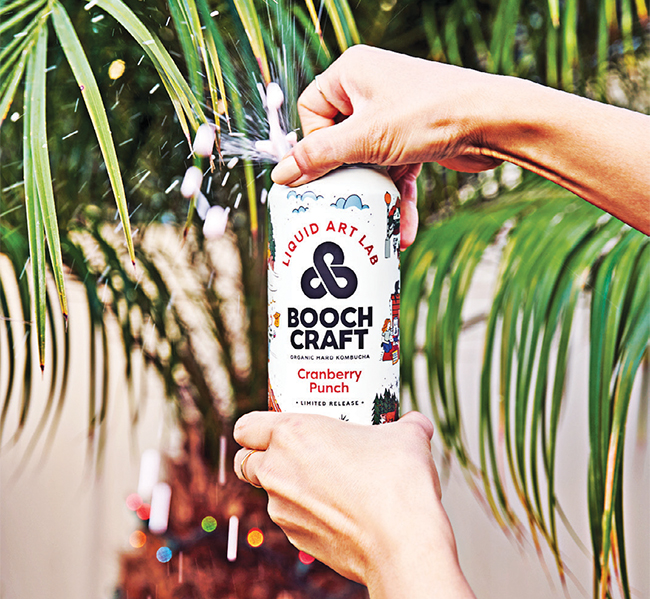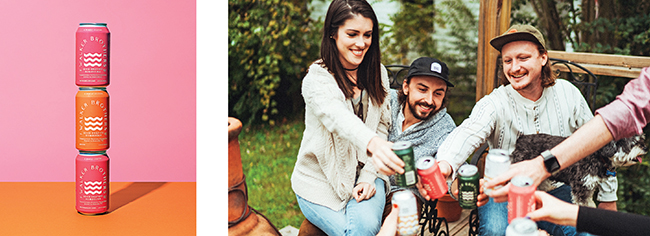Hard Times: Booze Finds Its Way Back to Booch
Kombucha’s rise over the past decade has been as much about what is not about in the bottle as what is. After multiple brands were pulled from grocery store shelves in the early 2010s amid concerns about alcoholic content, brewers have gone to various lengths to verify their alcohol content — naturally produced during fermentation — as coming in below the 0.5% ABV legal threshold.
But after years of work, the efforts of a small handful of mainly West Coast brands to build a viable, standalone adult kombucha category are paying off. The category is forecasted to grow 75% in the U.S. by 2025, according to IWSR, while the Specialty Food Association’s State of the Specialty Food Industry Report 2022-2023 cited hard kombucha as one of the growth drivers that helped specialty beverages to grow twice as fast as food in 2021.
That momentum has helped attract the interest of major strategics like Beam Suntory, which led a $20 million Series C funding round in Flying Embers, the hard kombucha brand created by KeVita co-founder Bill Moses, in January. Other CPG venture players like PowerPlant Partners and Beechwood Capital were also involved. Meanwhile, in October California-based JuneShine announced the opening of its third taproom (and first East Coast location) in Brooklyn, which will offer ten hard kombuchas on draft alongside a small food menu when it debuts later this winter. That move was largely fueled by a $24 million investment last year led by VC groups Amberstone and Litani Ventures, each of which have broad CPG experience.
As drinkers seek more adventurous and better-for-you alternatives to hard seltzer, alcoholic kombucha has been the beneficiary.
“There have been major shifts in the consumption habits of alcohol over the last few years, with a major focus on more intentional choices when people are choosing to drink,” said Abbey Schoenberg, Marketing Director at Boochcraft. The San Diego-based company has been one of hard kombucha’s early success stories, growing from a small operation to being sold in 7,000 stores across 12 states, though its primary focus has been in on-premise accounts.
The rise of West Coast brands like Boochcraft helped inspire Sam and Luke Walker to launch their eponymous brand Walker Brothers in Nashville. Hard kombucha was always the goal from the beginning; its non-alcoholic versions, released in 2019 while awaiting approval to begin producing the boozy kind, is a modular business that can provide some “insulation” for the company overall, according to co-founder Caroline Walker. The company’s four hard kombuchas — available in Watermelon Lime, High Gravity Ginger, Blueberry Juniper and High Gravity Passion Fruit — are unpasteurized and come in at 5% ABV per 12 oz. can.
Some years ago, the idea of national brands playing on either side of the alcoholic kombucha divide might have been considered risky; category leader GT’s revamped its package label design to clearly distinguish its alcoholic and non-alcoholic lines, while various brands have adopted or advocated for alcohol-free verified certifications. But there are also signs that barriers may be starting to crack, if not fall completely: see the release of Health-Ade’s three-SKU mixer line last year, or Aqua ViTea’s introduction of After Glow (5% ABV).
Others like Arizona-based jun kombucha maker Wild Tonic have leaned into both sides: along with its recently rebranded 5.6% ABV line, the brewer is adding new flavors to its Wanderer series of “cocktail inspired” non-alcoholic jun that is “almost identical to the flavors of their alcoholic (counterparts),” according to Jessica Gerth, director of sales and marketing at Wild Tonic.
With a vast sea of small players fighting for share, Sam Walker said he sees echoes of craft beer in the hard kombucha category, where narrow opportunities for national distribution are helping gestate robust regional markets and push breweries to go deep rather than wide. His plan for Walker Brothers is to “play the regional craft kombucha game” by building a strong base in the Southeast, betting that the overall category will continue to develop.
Within the store, however, the challenges may be different, as Walker explained. In the already mature non-alcoholic kombucha category, consumers have come to expect unpasteurized, refrigerated products; as such, retailers retain cold-box space specifically for them. Despite also being unpasteurized, hard kombucha enjoys no such protection, as brands like Walker Brothers are forced to fight for their cooler slots against all types of other alcoholic beverages. Add on cold-chain logistical hurdles and a rapidly proliferating canned RTD cocktail market and it’s clear that competition is getting tougher, Walker said, forcing his company to reconsider its approach.
That means finding workarounds to practical issues; faced with soaring rates for less-than-truckload (LTL) cold shipping, the company began wrapping pallets in reusable insulation so they could be shipped dry. Yet at retail, merchandising tools like end caps, secondary displays and floor stacks remain off limits as long as it is restricted to the cold box. Solving that problem ultimately takes Walker back to the issue of pasteurization itself, with the company setting the goal of finding how to make its hard kombucha shelf-stable by 2023.
“It’s tough to go in as a brand and stand by your morals and say ‘we’re unpasteurized because of this and this’ and fight for the space when maybe there is a lack of understanding of why that is important from the retailer and the consumer. I think that has been tough for us,” Walker said. “And that’s been leading us to investigate how important is being unpasteurized in this category?”
With its health halo knocked slightly askew, hard kombucha consumers tend to be more interested in taste experience than the drink’s better-for-you properties. Walker said his brand initially made efforts to keep ABV low enough to maintain residual probiotics, thinking that better-for-you callouts would enhance its appeal. Yet that wasn’t the case, according to Caroline Walker, as hard kombucha drinkers tended to “focus on how it makes them feel versus why it makes them feel that way.”
That can put the onus back on brewers to come up with innovative flavors, Schoenberg noted.
“The challenge we face is melding familiarity with the boldness that our customers desire,” she said. “Familiar can’t mean mild, as our customers gravitate toward bold, full bodied flavor, which we will always deliver. As we approach innovation in the coming years, it’s about finding that balance between familiar flavors and interesting combinations to deliver a pallet pleaser with every sip.”
Non-Alc: Innovation Spurs Expansion
Probiotic seltzer, anyone? More like probiotic seltzer, everyone.
Whether prebiotic, probiotic or placed somewhere under the general banner of “gut health,” you know them when you see them. The growth of shelf-stable, kombucha-adjacent CSDs has been one of the major developments within the space over the past several years, and it’s showing no signs of slowing.
For kombucha makers, the extension makes a lot of sense, ticking boxes for innovation that both widens their offerings and circumvents some of the production and distribution challenges related to raw kombucha. Most of these have come in the form of gut health-boosting seltzers and soft drinks: along with moving its core line from glass bottles to cans, New York-based Bear’s Fruit introduced its first non-kombucha product, a sparkling water made with the Bacillus subtilis probiotic strain, in July, while North Carolina’s Tribucha launched SuperB, a four-SKU line of fermented beverages dubbed as “soda redefined” at the beginning of this year.
The range of brands making the leap into gut-health CSDs reflects a market that is still wide open with low barriers to entry. Vermont-based Aqua ViTea, a longtime proponent of raw, unpasteurized kombucha, jumped in the shelf-stable game in July with the introduction of Aqua Seltzer, a four-SKU line boasting five billion live probiotics per 12 oz can, plus just 15 calories and 1 gram of sugar. Two months later in September, CBD drink and gummy maker Daytrip followed suit with its prebiotic soda line.
That diversification brings to question whether kombucha brewers can truly claim this new functional sub-category as their own – as Revive, Humm, Health-Ade have all attempted with their own shelf-stable line extensions – or if brands that have been working exclusively in the space – like Culture Pop, Poppi and Olipop – have already beaten them to the punch.
Regardless, as large strategics lean out of refrigerated beverages in general — as reflected in the recent spate of sales for once-vaunted cold-pressed juice businesses like Suja, Naked and Evolution Fresh — it’s unlikely that the momentum away from cold-chain will reverse in the years ahead.


Receive your free magazine!
Join thousands of other food and beverage professionals who utilize BevNET Magazine to stay up-to-date on current trends and news within the food and beverage world.
Receive your free copy of the magazine 6x per year in digital or print and utilize insights on consumer behavior, brand growth, category volume, and trend forecasting.
Subscribe



